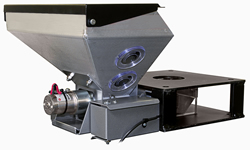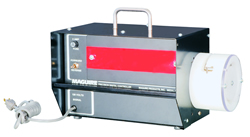Comparing Doser Technologies
.jpg)
For processors wishing to take advantage of simple, at-the-process-machine throat dosing of additives like color, there are several choices, each with their own set of pros and cons.
Volumetric Dosing Feeders
Typically using an auger, a volumetric dosing device uses the relationship between the flights of an auger (the volume of that space) and the calibrated weight of the material caught in that space, to meter material at a given rate. Coupled with a speed controlled motor, the processor can use a volumetric metering device to introduce additives into a flow of material, typically virgin or virgin with regrind. The advantage is simplicity; a simple DC motor and an auger, cutting through and pulling material from the base of a supply hopper and into a stream of base materials, just prior to processing. The downsides of this method are accuracy and the need for calibration. Accuracy suffers in many ways, since the basis of operation is approximating, calculating or repeatedly testing to determine the relationship between auger volume and speed and the delivered weight of additive material. The actual weight of the metered material is only weighed one time - during calibration.
.jpg)
Thereafter, the dosing device only delivers on time and rate and presumes that both will be constant enough to assume (but never actually re-measure to confirm) a certain level of accuracy.
Gravimetric Dosing Feeders
Using an auger, like its volumetric ancestor, the gravimetric dosing device actually dispenses an additive based on weight; the same unit of measure on which processing specifications are based. After initial set-up, calibration is not required, since the unit actually weighs each dose to assure accuracy. Changes are made to the speed and/or time the auger rotates in order to deliver the needed rate, but changes are produced automatically and triggered by the weight readings that guide the operation. Typically, devices of this level of sophistication have cost much more and their reliability in vibration-prone processing environments was questionable. But today, the prices for sophisticated controls that are programmed to overlook vibration and rugged load cells are very reasonable and gravimetric units are rapidly becoming the tool of choice for savvy processors looking to simplify their operation with reliable means for dosing additives at the feed throat.


Liquid Coloring
Liquid coloring is also administered at the throat of processing machines to blend liquid color with a flow of virgin material. Depending upon the product being produced and the particular characteristics required, mixing of the color with the material may also be required prior to the entrance of the mix into the machine but in many cases, due to the nature of liquid color, mixing is adequately provided within the process itself, without the need for pre-mixing.
Color is generally dosed through the use of a peristaltic (or “roller”) liquid pump, utilizing the precise rotation of a metering roller that is designed to move liquid through a circumferential flexible tube at a given volumetric rate and speed. The color, once it comes into contact with the pelleted material, disperses efficiently and effectively adheres to a majority of the pellets, assuring its coloring effect upon the pellets in the melt stage of the process.



